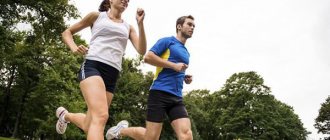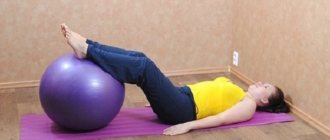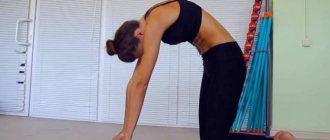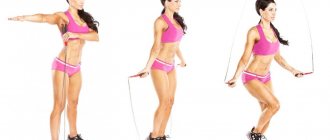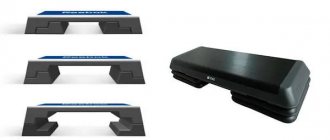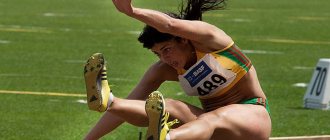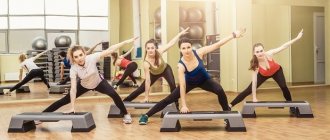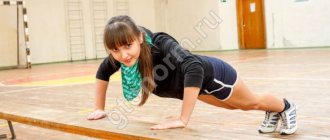Walking is one of the fundamentals of human existence. It is akin to movement, because every day, hour, minute we are in a moving state. Thanks to this, the energy balance in the body is maintained, processes associated with metabolism are stimulated, and the cardiovascular and muscular system is simply strengthened. Over time, people have turned walking into something more than just a walk in the park. Many means have been invented to diversify the seemingly monotonous, but healthy walking. Scientists began to conduct experiments and found that you can walk not only for health benefits, but also to strengthen it and even improve the appearance of the body.
Today, there are dozens of programs for people who want to get rid of extra pounds. Wherever you look, no matter what program you choose, there will be exercises that include various types of walking and running. Running is a metabolic accelerator. It is easy to notice that after 30-60 minutes of intense running, a feeling of thirst and then hunger arises. And all because the blood begins to circulate throughout the body faster than usual, and the process of oxygen supply occurs, accordingly, faster. But there is very little oxygen from the environment, so the body begins to process secretion products into oxygen. Due to this, metabolism is accelerated and the feelings described above are enhanced.
This article will focus on types of walking. We will also look at how much weight you can lose by walking and how to do it correctly.
Types of walking
In general, six types are distinguished. So, let's list them:
- walking (usually less than 2 km per hour);
- walking at an average pace (with this type of movement you can walk 1 km in 10 minutes);
- Nordic walking with specialized poles;
- energy-consuming walking;
- race walking (you can cover 1 km in 6-8 minutes);
- very fast walking (the speed of this type is more than 8 km per hour; such results can only be achieved through constant training).
Tips for Beginners
Have you decided to take up race walking? Then follow our simple tips:
- Start with short workouts (15-20 minutes) 3-4 times/week. Increase the pace and duration of training by no more than 10% per week;
- Record yourself on video to see technical errors + correct them;
- Be sure to warm up before training and cool down after;
- Close the carbohydrate-protein window after training, drink isotonic liquids;
- There should be 1.5-3 hours between training and meals (depending on the composition of the diet);
- Choose a soft track (dirt, arena) without holes or bumps. A treadmill will not work.
Race walking technique
Did you think walking was that easy? If you really caught yourself thinking this way, then get ready to find out that everything is not as simple as it seems. Sports or physical training type of walking is the most difficult of all.
The main feature of race walking is the fixation of a two-support position. Many are now asking the question: “What does this mean?” This means that when walking, the swing leg, which is carried forward, must step on the ground before the toe of the supporting leg comes off the surface. And the second important principle is that with each step, the leg on which the emphasis is placed must be straightened at the knee joint.
This looks more like a cross between walking and running.
The speed that can be achieved through race walking may vary. It all depends on the frequency and length of steps.
When walking, carry the entire weight of your body with the least effort. To do this, you need to straighten your back and lower your shoulders (that is, relax them). The legs should not be too tense, but use the joints fully.
As for the position of the arms, they need to be bent at the elbow joints and moved parallel to the body. This is a very important aspect, since you can use your hands to add more speed to your steps. Do not strain your brushes too much. If you want to give maximum speed to your movement, bend your elbows more.
Don't forget about your torso, which should be straight, chest straightened, and lower abdomen tucked.
Effect on the human body
The human walking technique is called "double pendulum". During the forward movement, the leg that leaves the ground moves (swings) forward from the hip. This is the first movement of the “pendulum”. Then the foot touches the ground with the heel and rolls onto the toe - this is the return movement of the “pendulum”. The movement of both legs is coordinated so that one or the other leg is always in contact with the ground. This is how walking differs from running - running has a ballistic phase, where both legs of the runner are in the air.
Did you know? According to scientists, at the beginning of the last century, an ordinary person covered a distance of 75 thousand kilometers on foot in his life. For our contemporaries, the pedestrian “life path” has been reduced by almost a third, its length is 24 thousand kilometers.
Humanity uses many types of walking in practice (sports, recreational, therapeutic, Scandinavian, etc.), and all of them are very beneficial for health.
Walking for even a minimal period of thirty to sixty minutes a day, five days a week, significantly reduces health risks and the chance of cancer, type 2 diabetes, heart disease, anxiety disorders and depression.
Life expectancy increases even for people who are obese or have high blood pressure. Walking also improves bone health, especially strengthening the hip bones, and also lowers the body's levels of low-density lipoprotein (LDL) cholesterol and increases healthy high-density lipoprotein (HDL) cholesterol.
Important! Scientific research has shown that regular walking may also help prevent acquired dementia and Alzheimer's disease.
Benefit
Regular walking exercises reduce the risk of the following diseases:
- coronary heart disease;
- strokes;
- diabetes;
- high blood pressure;
- bowel cancer;
- osteoporosis.
General effects of walking on the human body:
- increases strength and endurance;
- trains and develops body muscles;
- strengthens the joints of the lower extremities, which prevents arthritis;
- promotes weight control;
- reduces blood pressure;
- significantly improves the condition of the cardiovascular and digestive systems;
- increases lung capacity;
- increases life expectancy;
- reduces stress;
- improves memory;
- concentrates attention;
- increases learning abilities;
- increases life expectancy;
- improves mood.
Harm
Since walking can be done in different ways, some types of this physical activity require athletes to spend quite a lot of energy, which can have a bad effect on the health of certain people.
Patients at risk include:
- with cardiac diseases;
- having vascular diseases;
- after a heart attack or stroke;
- with high blood pressure;
- for any exacerbation of chronic diseases;
- with ophthalmological problems (glaucoma);
- with a lot of weight;
- with lung disease.
Important! People with the above diseases are contraindicated from even walking in place, so any physical activity should be discussed with their doctor.
Possible harm:
- If classes are irregular, or a person walks exclusively on smooth asphalt, not all muscles take part in the training process, which means that some muscles do not receive blood. This causes an increase in cardiac workload, and as a result, the occurrence of diseases. The most famous of them is varicose veins. To prevent varicose veins, walk on uneven surfaces (cobblestones, pebbles, paving stones). This “humpback” route is an excellent prevention of hypertension.
- Pain when walking may appear in the lumbar region, hips or calves. Such a nuisance can occur if, while walking, a person has incorrect posture, is overweight, sets the pace too high, or is wearing uncomfortable shoes.
What are the benefits of walking?
Everyone knows that walking is not only a way to maintain vital activity and tone the body as a whole, it is also a way to lose weight. No matter what type of walking you do, any type of walking helps develop a good respiratory system. It is important not to forget to breathe correctly, because a lot depends on it. For example, how the metabolism will proceed, quickly or slowly, with or without failures. Let's take a closer look at the benefits of walking and list some aspects of what exactly walking helps with.
Shoe selection
Sneakers for race walking should not have thin soles. By the end of a long distance, the feet will experience enormous pressure, so every pebble will be felt. In addition, in sneakers with thin soles, your feet will begin to hurt after the first kilometers. A common mistake women make is wearing shoes with hard heels, such as ballet flats, to workout. The best option for training is a thick sole. In any case, shoes for race walking should be light. Hard rubber soles are excluded, as they will cause a lot of discomfort to the feet. In rainy weather, sneakers with anti-slip film are best.
Strengthening the respiratory system
This is the first way the type of physical activity we are considering today can help. We present a number of very important rules for breathing while walking.
- When playing sports, you need to breathe through your nose. Try to develop a sense of the rhythm of your steps, combining them with inhalation.
- It is best to carry out physical activity away from the roads.
- When the temperature outside is below zero degrees, exhalation after inhalation should be done after 2-3 steps in order to avoid respiratory diseases.
- In order to quickly get used to the rhythm of your movements, you can use a music player as an assistant.
- Don't forget to monitor your pulse. 10 minutes after stopping intense walking, do not forget to feel for it. The heart rate should be fully restored by this time period.
Competition rules
Olympic walking involves a huge number of rules. Their compliance is monitored by a whole team of judges - from 6 to 9 people. Moreover, the placement of judges along the distance is also of fundamental importance.
Let's discuss everything in order:
- There are a number of violations that are recorded by the judges: loss of contact of the legs with the ground, bending of the knee.
- For the first violation, the athlete is shown a yellow card with a wavy line, for the second - a yellow card with 2 straight segments at an angle of 150 degrees;
- One judge can only show one yellow card to one athlete. If the same violation is repeatedly recorded by the same athlete, the judge gives a red card to the chief “arbiter”;
- When one athlete receives 3 red cards from different judges, he will be disqualified from the competition.
Features of judging are as follows:
- Violations are detected visually. Therefore, in the future, marathon walking will be complemented by the introduction of insoles with electronic chips - RWECS technology. Such insoles will allow you to accurately record violations when your feet lose contact with the ground;
- The judges are placed according to the distance at the most difficult places. For example, when descending at an angle, it is difficult for an athlete to maintain high speed + avoid the flight phase. This is where the maximum number of violations is recorded.
Varieties of tempos
The degree of stress on the body depends on the pace of running, so you should pay attention to the following classification:
- Slow pace. This is how sick people and those recovering from surgery or the same illness are advised to walk. Typically, the pace of such a group varies from 60 to 70 steps per minute.
- Average temp. It is typical for beginners, 70-90 steps per minute and is the very indicator that you should stick to if you are one of this type of people.
- Fast walking is recommended for all healthy people. It is believed that 90-110 steps is the optimal indicator.
- For those who exercise daily for a long time, there is a very fast type of walking. At this pace, people walk 110-130 steps per minute.
- The fastest pace is over 130 steps per minute; it is very difficult to adapt your body to such loads.
After familiarizing yourself with the different types of walking, you can choose the type and pace of exercise that suits you.
The main principle will be systematics. Monitor your pace and heart rate. Healthy walking helps improve the functioning of the cardiovascular system, prevents cancer, increases a person’s performance and level of psycho-emotional background.
Let's start classes
First, you need to understand why a person starts playing sports. If he wants to strengthen his muscles or just warm up, then it is enough to arrange daily half-hour classes. Some women set weight loss goals. In this case, walks should take up to an hour at a fast pace.
Many beginners start classes without warming up and without knowing basic skills. It is important to understand what race walking is, how to move correctly, how to breathe, etc. It is strictly contraindicated to strain the body in the first month of training. It is better to start classes early in the morning. At this time, it is easier to burn the maximum number of calories. In addition, morning workouts will tone the body for the rest of the day.
Nordic walking
“Why Scandinavian?” - this question can be heard quite often. And all because this type of transportation was invented in the Scandinavian countries. Most of us know why countries near the Arctic Ocean are primarily popular. This is cross-country skiing and walking. But how to ski in the summer, that’s the rub, but even here the descendants of the Vikings found a way out - they took ski poles with rubber tips.
The essence of walking is that the arms move alternately with the legs. With the help of sticks, the upper body is strongly worked out, unlike regular walking. This type can most likely be included in the category of “weight loss exercises”, because in an hour of such training you can lose about 400 kcal. It improves the functioning of the heart muscle, lungs and strengthens the whole body.
Walking poles are not made from ordinary materials. Fiberglass coupled with carbon are the main components of this piece of equipment. The handles follow the anatomy of the palm and allow you to move without discomfort, and carbon makes the poles elastic. It is this elasticity that allows you to absorb most impacts on your hands. To choose sticks, you need to use one simple formula: “human height” * 0.68.
What type of walking will help you lose weight, read below.
How to warm up properly
First, you need to start by stretching your calf muscles. To do this, you need to rest your hands on the wall, move one leg back, and raise and lower your body with the other (supporting leg). The exercise should consist of 8-10 approaches and last up to 7 minutes.
To warm up the back of your thigh, stretch your leg forward and place it on a stool. Next, you need to slightly tilt the body towards it. The front area of the thigh is warmed up with the following exercise: one leg is the supporting leg, and they try to bring the foot of the second as close as possible to the buttocks with their hand.
The hips are warmed up by alternately lunging the body forward and backward with the foot placed on a stool. For this control it is important to relax extremely.
According to athletes, warm-up should last at least 20 minutes. During this time, all muscles should not only be stretched, but also warmed up well in order to protect yourself from unnecessary injury.
Walking for weight loss
Let us immediately warn you that to achieve any results you will need maximum effort. Every day, a person trying to lose 2-3 extra pounds needs to walk at least 10,000 steps at a high pace. It should take approximately 12 minutes to walk 1 km.
To see the result in the mirror, you need to walk 12 km daily. Equip yourself to the fullest - wear weights on your feet and clothes that keep you hot. If you want to diversify your workout, you can climb up the stairs, as this process also burns a sufficient amount of calories.
How many steps should you take per day?
There are many myths spread on the Internet and the media about how much distance you need to cover every day. The most popular figure is 10,000 steps (about 7-8 km). It appeared in the 60s of the 20th century in Japan in connection with the invention of the first electronic pedometer.
However, neither the WHO nor other medical institutions provide official recommendations on how much walking should be done per day. After all, the exact answer depends on a number of factors:
- gender;
- age;
- health conditions;
- physical endurance;
- lifestyle.
In addition, you need to take into account not just the number of steps, but all types of physical activity in the aggregate. After all, a person may not go for a walk, but he can unload the carriages for a day or do a general cleaning of the apartment.
Most healthy people who do not exercise benefit from walking 6,000-10,000 steps per day. At an older age or after suffering injuries, you can reduce this bar.
Power walking
When you walk, you think little about what you are doing, what your actions are aimed at, what you want to achieve. Energy walking is just a meaningful and systematic movement of the body. During such loads, you should be as focused as possible on the result and tell yourself a goal. Feel the surge of energy, direct it in the right direction and focus as much as possible on what is happening.
We looked at all the main types of walking and their features. Don’t forget that movement is life, and you need to live healthy.
